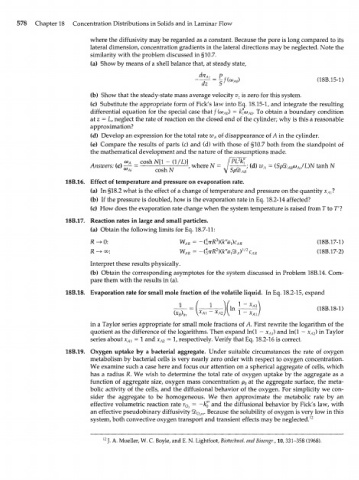Page 598 - Bird R.B. Transport phenomena
P. 598
578 Chapter 18 Concentration Distributions in Solids and in Laminar Flow
where the diffusivity may be regarded as a constant. Because the pore is long compared to its
lateral dimension, concentration gradients in the lateral directions may be neglected. Note the
similarity with the problem discussed in §10.7.
(a) Show by means of a shell balance that, at steady state,
(b) Show that the steady-state mass average velocity v z is zero for this system.
(c) Substitute the appropriate form of Fick's law into Eq. 18.15-1, and integrate the resulting
differential equation for the special case that / (o) ) = k"to . To obtain a boundary condition
A0
A0
at z = L, neglect the rate of reaction on the closed end of the cylinder; why is this a reasonable
approximation?
(d) Develop an expression for the total rate w A of disappearance of A in the cylinder.
(e) Compare the results of parts (c) and (d) with those of §10.7 both from the standpoint of
the mathematical development and the nature of the assumptions made.
Answers: (c) ^ = C O S h M 1 ~ " / L ) i , where N = , / Ц ^ ; (d) w = (Sp<3> a> ,/LW tanh N
"M< cosh N \ SP~VAB A AB A
18B.16. Effect of temperature and pressure on evaporation rate.
(a) In §18.2 what is the effect of a change of temperature and pressure on the quantity х ?
Л]
(b) If the pressure is doubled, how is the evaporation rate in Eq. 18.2-14 affected?
(c) How does the evaporation rate change when the system temperature is raised from TtoT?
18B.17. Reaction rates in large and small particles.
(a) Obtain the following limits for Eq. 18.7-11:
R -> 0: W AR = -{lTrF?)(k%)c AR (18B.17-1)
/2
R -* *>: W AR = -{\irR ){k%9) y c AR (18B.17-2)
2
A
Interpret these results physically.
(b) Obtain the corresponding asymptotes for the system discussed in Problem 18B.14. Com-
pare them with the results in (a).
18B.18. Evaporation rate for small mole fraction of the volatile liquid In Eq. 18.2-15, expand
(x ) \x - x )\ i -
B [n M A2 x
in a Taylor series appropriate for small mole fractions of A. First rewrite the logarithm of the
quotient as the difference of the logarithms. Then expand ln(l - x ) and ln(l - x ) in Taylor
M
A2
series about x = 1 and x = 1, respectively. Verify that Eq. 18.2-16 is correct.
M A2
18B.19. Oxygen uptake by a bacterial aggregate. Under suitable circumstances the rate of oxygen
metabolism by bacterial cells is very nearly zero order with respect to oxygen concentration.
We examine such a case here and focus our attention on a spherical aggregate of cells, which
has a radius R. We wish to determine the total rate of oxygen uptake by the aggregate as a
function of aggregate size, oxygen mass concentration p at the aggregate surface, the meta-
0
bolic activity of the cells, and the diffusional behavior of the oxygen. For simplicity we con-
sider the aggregate to be homogeneous. We then approximate the metabolic rate by an
effective volumetric reaction rate r , = -к™ and the diffusional behavior by Fick's law, with
o
an effective pseudobinary diffusivity Q . Because the solubility of oxygen is very low in this
Oim
system, both convective oxygen transport and transient effects may be neglected. 12
12 J. A. Mueller, W. С Boyle, and E. N. Lightfoot, Biotechnol. and Bioengr., 10, 331-358 (1968).

